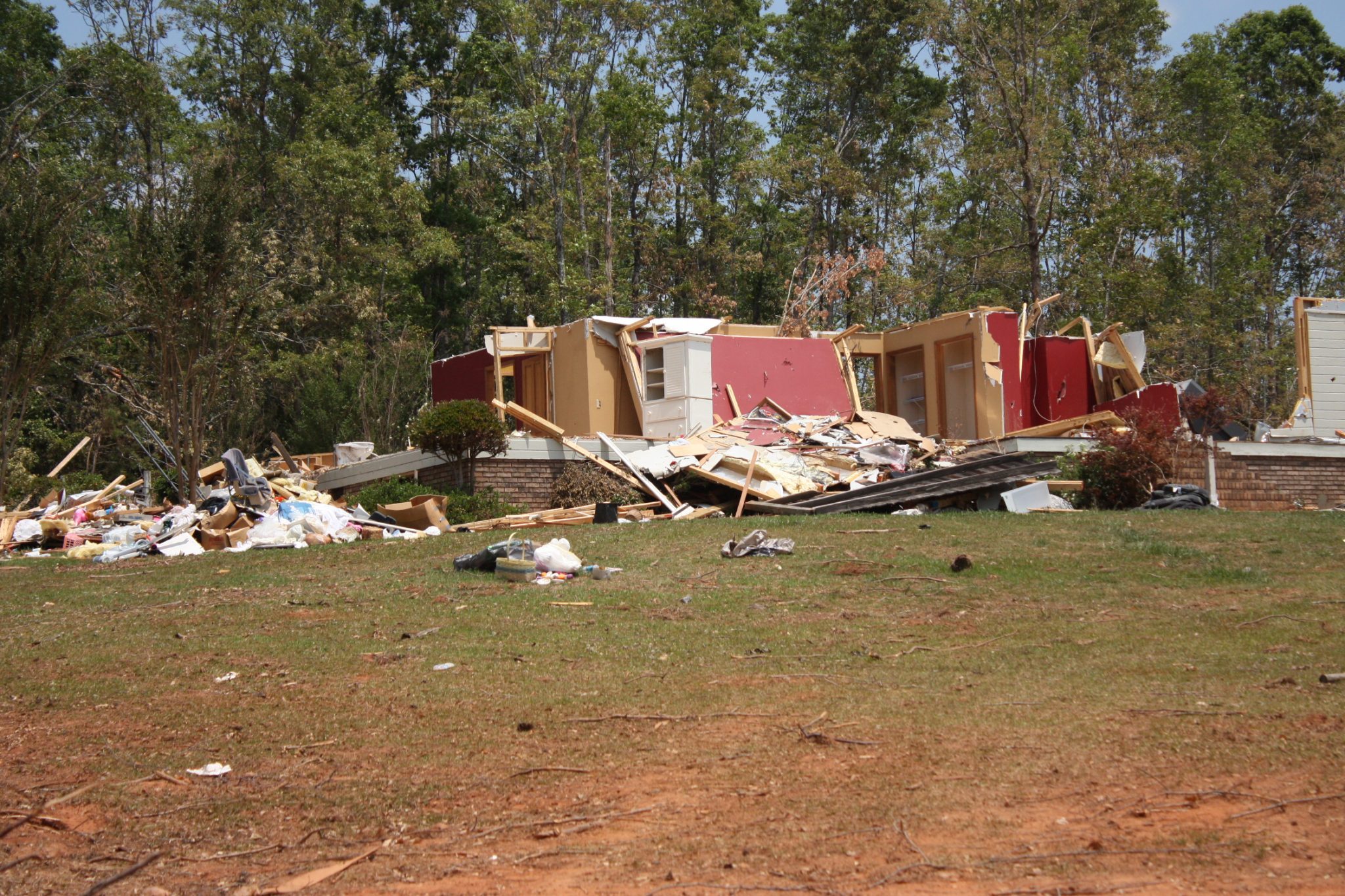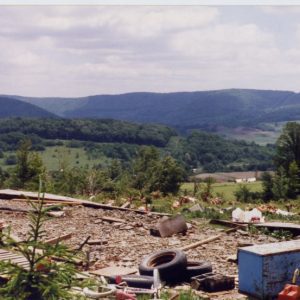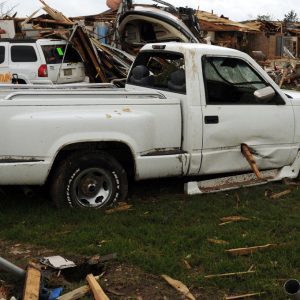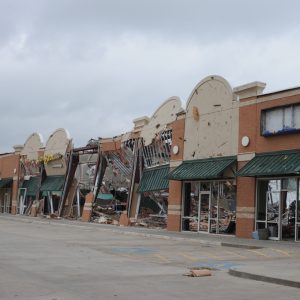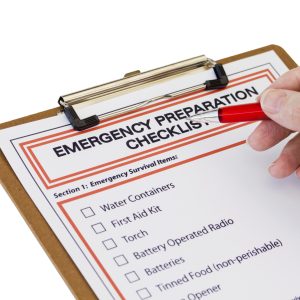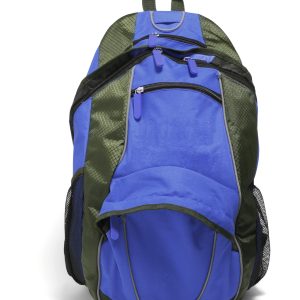Disaster

Tornadoes are dangerous and can be deadly. Stay safe by recognizing conditions that may develop into a tornado. Learn about tornado watches and warnings, NOAA weather radios, safe and unsafe locations during tornadoes, fun things your kids can do to get ready, and ways to protect you and your family.
Tornadoes are dangerous and can be deadly. More tornadoes strike the central United States than any other place in the world. The peak of tornado season is April through June, with a second peak in the fall. A tornado, however, can occur during any month and at any time of day.
Tornadoes can occur anywhere, including Alabama. During the last 10 years, the state has averaged 63 tornadoes per year. In 2011, the state was hit by 145 tornadoes, more than twice the 10-year average. To find out how other states compare, see the National Climatic Data Center for maps of documented tornadoes.
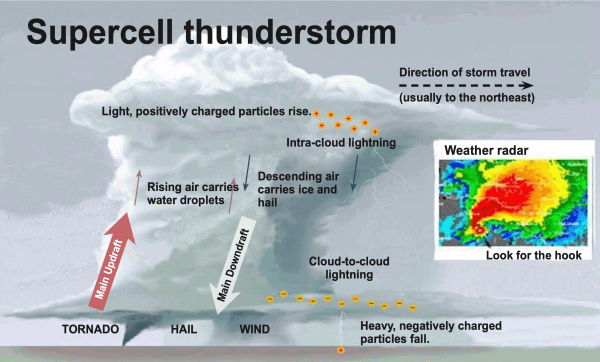
Tornadoes typically form in a supercell thunderstorm that has an organized internal structure characterized by a single, rotating updraft. (Photo credit: National Oceanic and Atmospheric Administration.)
How Will You Know You Are in Danger?
Recognizing conditions that may develop into a tornado is one of the most important components of storm safety. According to the National Weather Service (NWS), tornadoes typically form in supercell thunderstorms. A supercell thunderstorm has an organized internal structure characterized by a single, rotating updraft.
A funnel cloud is a region of strong rotation in a thunderstorm. The funnel cloud becomes a tornado when it reaches the ground. Storm watchers look for dust and debris on the ground beginning to rotate as an indication that the circulation has become a tornado. Learn more about thunderstorms from JetStream, An Online School for Weather from the National Weather Service.
Most people become aware of tornado danger through watches and warnings issued by the NWS. Stay alert to weather forecasts for information about potential severe weather. Weather bulletins and sky conditions will indicate an approaching storm. Listen to a National Oceanic and Atmospheric Administration (NOAA) weather radio, local television station, or radio station for weather information. You can also sign up from several sources to receive severe weather alerts on your cell phone or mobile device.
Storm Destruction
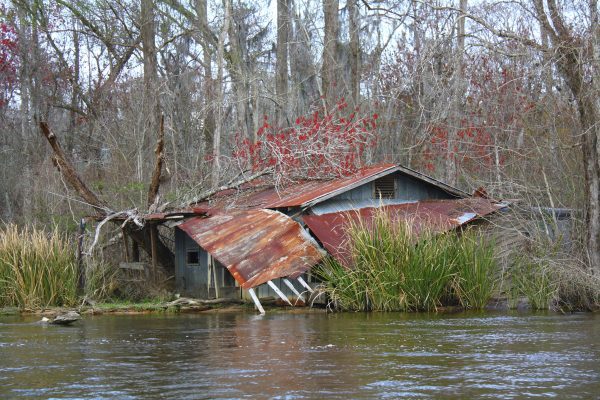 Straight-line winds may cause as much damage as a tornado. While the destruction may be similar to that of a tornado, the damage typically occurs in one direction along a relatively straight path. If the winds are greater than 57 mph at most points along the path, the windstorm is considered a derecho. According to the Storm Prediction Center, these windstorms are associated with bands of rapidly moving showers or thunderstorms.
Straight-line winds may cause as much damage as a tornado. While the destruction may be similar to that of a tornado, the damage typically occurs in one direction along a relatively straight path. If the winds are greater than 57 mph at most points along the path, the windstorm is considered a derecho. According to the Storm Prediction Center, these windstorms are associated with bands of rapidly moving showers or thunderstorms.
Know the Difference between Watches and Warnings
A tornado watch means that conditions are favorable for the development of tornadoes in your area. Be alert to approaching storms when your area is under a tornado watch. Watches are usually issued for 4 to 8 hours. A tornado warning means that a tornado has been sighted by storm spotters or indicated by weather radar. A warning can be issued without a tornado watch being in effect. Warnings are usually issued for about 30 minutes. If you are in the path of the storm, immediately go to your safe location.
True or False?
Areas near rivers, lakes, and mountains are safe from tornadoes.
FALSE: No place is safe from tornadoes.
Low pressure associated with a tornado causes a building to explode as the tornado passes overhead.
FALSE: There is usually enough air leakage through building connections to equalize the inside and outside pressure. Violent winds and debris slamming into buildings cause most structural damage.
- (Photo credit: NOAA)
- (Photo credit: FEMA)
- (Photo credit: FEMA)
- (Photo credit: FEMA)
Tornadoes don’t hit cities.
FALSE: Tornadoes have struck cities, including Fort Worth, Texas; Joplin, Missouri; Birmingham, Alabama; and Nashville, Tennessee. Living in an urban area does not protect you from tornadoes.
A safe room is the best protection from a tornado.
TRUE: Next to a safe room, the best place to be during a tornado is an interior room on the lowest floor of a building.
Keep a NOAA radio tuned in and turned on.
(Photo credit: NOAA)
NOAA weather radios can be purchased at most hardware, grocery, general merchandise, and drug stores. NOAA weather radio broadcasts the latest weather information, including severe weather details, 24 hours a day every day of the year. Service to a county depends on reliable signal reception. Some counties or parts of counties may not have reliable reception because of signal blockages, especially mountainous areas.
You can program your weather radio to receive messages for your county. Visit the NOAA Weather Radio All Hazards website for a list of states and territories. From there, click on the link to your state or territory and then choose the appropriate Specific Area Message Encoding (SAME) number for your location and program it into your radio.
A warning response process in place at Parsons Company near Roanoke, Illinois, saved 140 lives even as the plant was virtually destroyed by a tornado.
What Can You Do to Protect Yourself and Your Family During Tornadoes?
The keys to surviving a tornado are realizing that you are in danger, knowing where to go, and moving quickly. When a tornado is coming, you have very little time to make decisions that may mean life or death.
Well in advance of any storm, you can do five things that will help you.
1. Determine your safe places. Decide well ahead of stormy weather the best place to take shelter at home and in the workplace. Also be aware of designated storm shelters in public buildings and private businesses.
Safe and Unsafe Locations During Tornadoes
- In homes with basements. Seek refuge near the basement wall in the most sheltered and deepest belowground part of the basement. Crouch as low as possible to the floor, facing down, and cover your head with your hands. If you have a safety helmet, such as a bike, football, or motorcycle helmet, put it on. Cover yourself with some sort of thick padding to protect against falling debris in case the roof and ceiling fail.
- In homes without basements. Take cover in the smallest room, such as a closet or bathroom, on the lowest floor or in an interior hallway with no windows. Crouch as low as possible to the floor, facing down, and cover your head with your hands. If you have a safety helmet, put it on. Cover yourself with some sort of thick padding to protect against falling debris in case the roof and ceiling fail. A bathtub may serve as a shell of partial protection.
- In mobile homes and modular buildings. Get out! Plan ahead if you live in a mobile or modular home— they are extremely vulnerable to tornadoes and high winds. Arrange for the use of a convenient safe area in advance. Consider basements, a storm shelter, the ground floor of a sturdy structure, or a nearby culvert or deep ditch.
- In office buildings, hospitals, nursing homes, hotels, apartment complexes. Go to an enclosed, windowless area in the center of the building. Get as far as possible from glass. Go to the lowest floor and crouch as low as possible to the floor, facing down. Cover your head with your hands. If you have a safety helmet, put it on. Interior stairwells are usually good places to take shelter. Stay off elevators; you could get trapped if the power is lost.
- In large buildings with wide free-span roofs. Factories, auditoriums, and other large buildings with wide free-span roofs are particularly vulnerable to tornadic wind damage because of the large roof expanse that wind forces out and the distance between roof-supporting walls. If the buildings have basements, go there. Small interior rooms at ground level or nearby sturdy buildings are options, depending on their construction and urgency for shelter. Look for and go to marked safe areas. Follow instructions from authorized personnel.
- In a car or truck. Vehicles are extremely risky places to be during a tornado. There is no safe option when a tornado catches you in a car, just slightly less dangerous ones. If the tornado is visible far away and the traffic is light, you may be able to drive out of its path by moving at right angles to the tornado. If you are caught by extreme winds or flying debris, park the vehicle as quickly and safely as possible out of the traffic lanes. Stay in the vehicle with the seat belt on. Put your head down below the windows and cover your head with your hands and any type of padding you can find to protect against flying debris. If you can safely get out of your vehicle and into a ditch that is noticeably lower than the roadway, lie there covering your head with your hands. Do not seek shelter under bridges or overpasses. If a tornado does not appear to be moving, it may be headed straight for you. Learn more by visiting the NWS Storm Prediction Center.
In the southeastern United States and other regions with large trees, tornadoes cannot be seen beyond the tree line. It is also difficult to see a tornado at night or when a tornado is rain wrapped. Other conditions affecting the visibility of a tornado include smoke, haze, steam, fog, and pollution.
2. Develop a plan. Develop a written plan of what to do in the event of a tornado and share it with your family or employees. The plan should include, among other items, the location of designated safe places, emergency contact lists, and a telephone tree with up-to-date contact information for each family member or employee. Familiarize yourself with your employer’s disaster plan so you will know what to do if a tornado hits while you are at work. Also check with your children’s schools to learn their plans.
Meet with your family or employees to discuss your plan. Point out the safest areas to ensure that everyone knows where to go for shelter. Review and update emergency phone numbers. Teach family members how to use a fire extinguisher and how and when to turn off water, gas, and electricity.
Practice emergency drills. Assemble in the assigned tornado shelter. Remind each person to use the phone only if there is no immediate danger and then only to notify family members of the violent weather concern. Post emergency phone numbers and safety rules by the telephone; add them to cell phones. Teach children how and when to call 911 or the local emergency medical service number.
3. Create a disaster supply kit. Whether the kit is for home or work, it should include food and water; medicines; copies of prescriptions; personal hygiene items; first aid supplies; important documents including personal identification and copies of insurance policies; cash or traveler’s checks; and other essential items such as flashlights, extra batteries, seasonal clothing, blankets, a battery-operated or crank radio, and cell phone chargers. Your work disaster supply kit should contain important papers relevant to your work—not those important documents or insurance papers that apply to your home. If you store a car kit in your vehicle, beware that food items may be affected by hot weather.
Make copies of important papers such as marriage and birth certificates, social security numbers, driver’s licenses, home and health insurance documents, and bank and credit card accounts. Store original documents in a safe deposit box, and make copies to go in a waterproof bag in your disaster supply kit. Lost papers can be difficult to quickly replace.
Food supplies should meet emergency needs for each family member for at least three days. Assemble an evacuation kit, and store supplies in sturdy, easy-to-carry containers, such as backpacks or duffel bags. Be ready to leave your home if authorities order evacuations. Remember to plan for your pets and family members with special needs and diets.
When severe weather threatens, dress appropriately. Wear sturdy shoes. Grab a waterproof jacket if you have time.
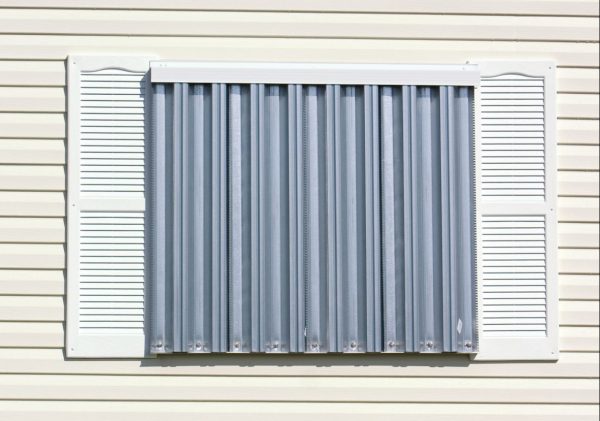 4. Make your home or business stronger. By taking actions to make your home resistant to high winds, you can reduce structural damage from hurricanes and tornadoes. A typical stick-built home has four crucial weak places that can be strengthened. They include the roof, exterior doors and windows, garage doors, and connections (roof-to-wall and wall-to-foundation).
4. Make your home or business stronger. By taking actions to make your home resistant to high winds, you can reduce structural damage from hurricanes and tornadoes. A typical stick-built home has four crucial weak places that can be strengthened. They include the roof, exterior doors and windows, garage doors, and connections (roof-to-wall and wall-to-foundation).
A gabled roof (looks like an “A” on the ends) is more vulnerable to wind forces than is a hipped roof (slopes upward from all sides). If not properly braced, a traditional gable wall end will flex in gusty wind and can collapse or be sucked off the building under high wind conditions. The gable-end wall can be strengthened with proper installation of truss and gable-end bracing inside the attic. Work with a qualified engineer or architect for proper bracing design.
Exterior doors and windows should be protected to prevent high winds from entering a home. Storm shutters provide effective protection and can be installed over windows and patio doors. Shutters or shields must be secured to the building (not to the window or door frame). Impact-resistant windows that are rated for differential pressures are a good alternative, but they are more expensive than simple shutters.
Garage doors can be pulled off their tracks as a result of wind pressure. Add strength to your garage door by installing horizontal bracing to each panel, replacing existing hinges with stronger ones, and checking the center and end supports for wind loads. If end supports are mounted on the building, it may be necessary to strengthen the building at those locations to prevent structural damage. Commercial garage door retrofit kits are available.
The wind blows laterally to the ground, so when it meets an obstruction, such as a building, the wind pushes against the structure. Wind also gets diverted around corners and over the roof, creating its greatest forces in these areas. Connections between the roof and walls and the walls and your foundation should be strengthened against the wind. Hurricane straps and clips, when installed correctly, will help hold the building together during a windstorm. They can be used to connect the roof to exterior walls and between floors. Exterior walls should be properly anchored to the foundation with anchor bolts.
FEMA’s Avoiding Hurricane Damage: A Checklist for Homeowners also provides information about reducing damage from high winds (hurricane, tornado, or straight- line wind) and water.
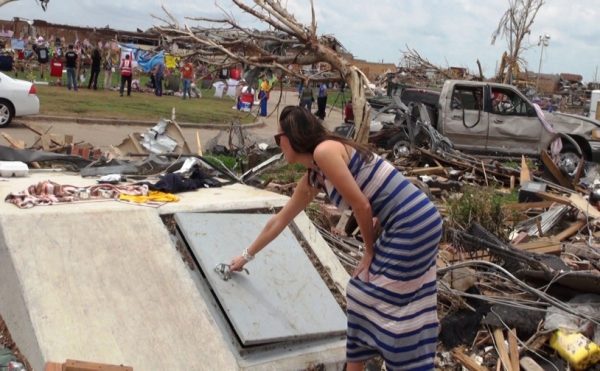
(Photo credit: FEMA)
5. Install a safe room. The best option for protecting your family or employees is to install a safe room. A safe room is a protective space built to withstand high winds and flying debris, even if the rest of the building is severely damaged or destroyed. Consider building a safe room in the basement, in an interior room on the first floor, or in the garage (an at-grade or above-grade safe room should have a concrete slab foundation or one that is engineered for this purpose). A safe room should meet or exceed the ICC-500 Storm Shelter Standard. Taking Shelter from the Storm: Building a Safe Room for Your Home or Small Business is a FEMA publication (P-320) with construction plans and cost estimates. It is a free download from the FEMA library as is Design and Construction Guidance for Community Safe Rooms (P-361).
If a building sustains a direct hit from an EF3 or higher tornado, it will experience significant structural damage. But with a safe room, at least part of the structure may be left standing.
Remember that tornadoes are destructive and can even be deadly, but you can take steps to protect yourself and your family from their impact. The most effective step is to install a safe room. If you don’t have a safe room, determine the safest location in your home or office and make sure your family and employees know where it is.
Fun Things Your Kids Can Do to Get Ready for Tornadoes and Other Disasters
- Let them practice saying or writing their names, your name, and your phone number.
- Take them to StormStruck: A Tale of Two Homes, an online interactive weather experience from the Federal Alliance for Safe Homes (FLASH) and partners at flash.org.
- Play games and test their knowledge at Ready.gov.
- Introduce them to Sparky the Firedog who has fun activities for young children. See the National Fire Protection Association website.
What Can I Do to Protect Myself?
Before stormy weather
- Develop an emergency storm plan for all family members whether at home, work, school, or outdoors.
- Teach children the name of their county and the names of surrounding counties because storm alerts are given by counties. Keep highway maps in several convenient locations to follow storm movement given by weather bulletins. Also use maps to plan multiple evacuation routes if you must evacuate. Stay especially alert when traveling in unfamiliar regions.
- Conduct frequent storm drills.
- Have a NOAA Weather All Hazards Radio with a battery backup and warning alarm to receive warnings.
- Listen to radio or TV for weather updates.
- If your activity is outdoors, listen to the latest forecasts and take necessary precautions during threatening weather. You may need to delay activities until the danger has passed.
If a tornado warning is issued or threatening weather approaches
- Move to a previously designated safe area, preferably a safe room.
- If a safe room is not available, move to a basement or an interior room or hallway on the lowest floor. Crouch under a sturdy desk or rugged furniture if it is located near a central wall. Place pillows or blankets over your upper body for extra protection.
- Stay away from doors and windows.
- Do not try to outrun a tornado in your car.
After the Storm Has Passed
When you assess damage to your home, keep in mind that some insurance companies may not cover damage that could have been prevented. For example, rains follow tornadoes. If you have a damaged roof and don’t take appropriate steps to prevent rainwater from entering your home, your insurance company may not cover the extended damage. Know your insurance options before a tornado strikes.
- Remain calm and try to deal with immediate problems until professional help arrives.
- If you suspect damage to your home or business, do not light matches or turn on electrical switches.
- Carefully check for damage around your home or business. If you smell gas or suspect a leak, turn off the main valve, open windows, and quickly get everyone out of the structure.
- Know where to find the main electrical fuse or breaker box, water service main, and natural gas meters. Know how and when to turn services back on.
- Stay away from downed lines of any kind. Do not attempt to touch or move them. Keep children away from downed lines. Report any downed lines to your power company.
- Clean up or rope off dangerous areas such as where broken glass is located.
- Trees and tree limbs may be weak and could fall unexpectedly, so be cautious when walking through treed areas where high winds or tornadoes have gone.
- Locate your emergency supply kit with essential documents and materials for taking care of yourself after storm damage.
- Remember to care for pets.
- Check on those near you who may need assistance. For example, senior citizens or people with mobility issues.
- Use Recovery After Disaster: The Family Financial Toolkit from the University of Minnesota Extension to find strategies and tools that can help you move toward financial recovery.
Revised by Emery Tschetter, Director, Extension Communications and Marketing, Auburn University. Originally written by Virginia Morgan White, former Extension Outreach Programs Administrator, Auburn University.
Thanks to Extension Disaster Education Network (EDEN) reviewers Rick Atterberry, University of Illinois at Urbana-Champaign; Steve Cain, Purdue University; and Pat Skinner, Louisiana State University
Revised October 2021, Tornado Safety, ANR-0983

